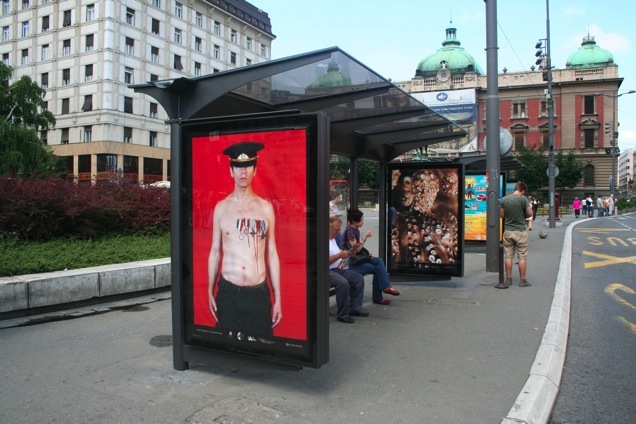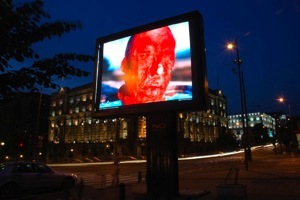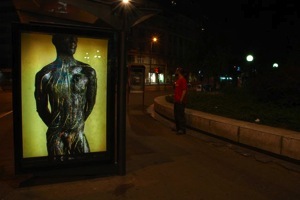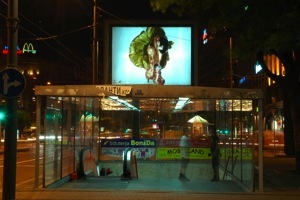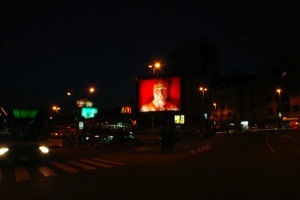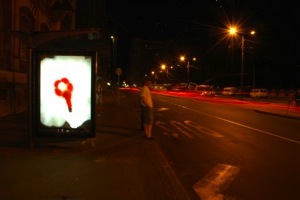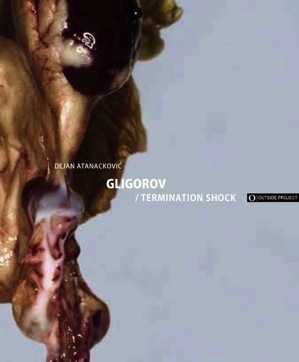Images Of Bodies As Frontiers
Dejan Atanackovic (text in catalogue Robert Gligorov: Termination Shock, 2007)
1
At about the same time as A.M., an insurance clerk from a small European town, first communicated on the Internet his desire to eat a man, the world media announced the passage of the spaceship Voyager into the zone named Termination Shock. As of that moment, we are told, the most distant human-made object in the cosmos stops obeying the laws of the Sun; free from any influence that could be directly blamed for causing life, it floats into darkness where, out of harm’s way, it will spend the years of decay of the distant humanity. Equipped with images and diagrams carefully selected to depict the world that the man had made in his own image and measures, and within the boundaries of language, Voyager is a carrier of selected information on various features of the planet and its inhabitants. Members of different communities are shown, as are their various social organizations, diets, behaviors and entertainments; their voices are recorded, their habitats documented, the achievement of the epoch described. The planet’s inhabitants, now seen gathered for a sports competition, now engaged in social, educational and symbolic activities, stand as the representatives of different races and nations, genders and ages, and their physical measures are conveyed in the form of strange, simplified diagrams. All of them, with their faces and bodies, are included in the group portrait of a desired and adequate humanity, and so this appropriate message, apparently intended more for local than cosmic communication, outlined by the signs of the epoch and the political moment, has been destined to drift into the infinity of open space. Perhaps it is precisely the recognition of the signs of past times that would make even a sarcastic bystander feel nostalgic and sentimental at the thought that this launching of a space ship is yet another attempt of survival, in which case all is permitted. Because only a moment later, when the waves have quieted down, will the fatal reflection of Narcissus emerge, the gaze condemned to eternal self-liking, and there will be life on the one side and void on the other, and between them a reflection, as a point of contact: fleeting, like an illicit act of love.
2
B. spoke fluent English. He read the bilingual ad on a local web site in both languages, his native German and English, and detected a curious grammatical error. In the English version, the verb “to eat” was used in a continuous form, as if suggesting the possibility of an uninterrupted, endless consummation. The rest of the ad was written correctly, which made B. wonder if perhaps this may have been an intentional mistake, a hidden message, in which he would have gladly recognized the beauty of the idea and the purposefulness of the act. To be eaten vs. being eaten forever. The first option sounded like a fairytale-like anecdote intended to scare children in order to set off their profoundly needed feeling of guilt. Or else, this could only mean total redemption, the act of surrendering oneself to the eternal ritual in which the body is disintegrated into an endless number of pieces and given to eternity. Amazed at the idea, which could be nothing short of an unwritten treatise on beauty, B. thought of his butchered body sliced up into tiny pieces, melting between the palates and the tongues of the consecrated ones in a ritual mourning and glorification of his absolute and impeccable sacrifice. The ad contained a code, and B. decided that he ought to reply as soon as possible, after all, this world is infested with fake ambition, arrogant selfishness, and all ideas, even the purest ones, are at risk of being badly abused.
3
In Robert Gligorov’s works, the body is shown at the moment of reaching its own limits – of pain, resilience, metamorphosis, contamination with the Other – in the scenes that make it look inseparable from its immediate communicational surroundings. It is exposed to the forces that come from nature and language, confirming how intertwined they are, making language and nature equally tangible environments, in which the body acquires its final shape. The body undergoes strange metamorphoses in contact with familiar organic structures: edible stuff, animals or plants appearing as disconcerting reminders of a childhood fear or childhood curiosity (which often is one and the same). By exposing to view the unexpected bowel contents, or displaying a cross-section of flesh and skin resembling a box of packaged foods, Gligorov links the bodily forms with the external organic world, and the result of these symbioses is as disturbing as the logic linking them together: tactile quality, texture and color become a blasphemous commentary on the importance and meaning of the body, now reduced to its seemingly less relevant, estheticized qualities. Whether that represents a devaluation of the body or, quite to the contrary, an added value, this question reflects reality in an equally problematic way as does the extreme utilization of the body in the acts of esthetic surgery and suicidal terrorism.
In fact, the surgeries which the body undergoes in Gligorov’s art are an obvious evocation of the fashion trends which, like premeditated violence, treat the body as luxury, insufficiently one’s own, but also a nuisance that can be eliminated or substituted in a number of ways. But at the same time, just like the interventions dictated by fashion, the surreal treatments of the body in Gligorov’s work are an expression of subjectivization of an already existing linguistic reality, which uses the body as sculpting material.
The idea of the body as a separable whole seems somewhat absurd – what is the body without the micro conditions that keep this sac of organs together, without the chemical environment, pressure and temperature, whose subtle balance ensures its sustainability? In that sense, the boundary of skin, mucous, hair, and nails is in fact an unreal, soft barrier, allowing a constant invasion of various biological intruders, and the exchange of matter that make the body possible.
Gligorov utilizes these physiological sets of conditions as narrative elements which allow the body – in a purely organic context, marked by temporal activities such as rotting, secreting, slicing, growing together – to be the protagonist of a fatalistic vision of reaching one’s own limits; and the real, tangible boundary of the body is only the one defined by the rules of language, by a grammar applied to anatomic functions; via the institutions providing the body with a name, origin, year of birth; exposing it to forced branding, filing and classifying, hygienic rituals, vaccination and dieting; dressing it, training it, teaching it to always occupy space; educating the body to repeat movements which convey appropriateness, eroticism or belligerence; enabling it to amass knowledge about itself and its environment. The result of this process is the existence of a sphere which gives the body a sort of a cultural anatomy, a corporality transferred to the space the body occupies and which, just like the body, bears the signs of power, submissiveness, sexuality and death.
In this sphere, this terminal placenta beyond which reigns eternal darkness, the body lives its anthropometric illusion of the world around it.
4
Every age, of which we are either hostages or witnesses, produces images of bodies stored in media archives - personal and collective memory - images whose appearance in the media sky contributes to the concretization and continuity of the tragedy. Reduced to a body, the political, moral and esthetic principles, like pagan deities, suffer from overstated humaneness. Sometimes, these images reach the beholder as exhumed corporal forms, whose recognizable anatomy springs out of abstract ideas, like patriotism or nation, the image of body made of mud and blood streaming out of some suicidal rhetoric. When in Gligorov’s photographs blood instead of rain showers down the windshield, or when military decorations are pinned onto bleeding skin, the rhetoric of these spectacles is just an example of the Body-Power relationship, whose verifications are numerous and picturesque. The images coming in through mass media, segments of the big memory – reports of suicide attacks, intelligent bombing, sexual harassment of prisoners of war, rape, mass graves – all offer a horrific variety of images in which the individual body is a conclusion of the beholder’s gaze, a sublimation of the events into an intelligible and tangible display.
The function of this image is two-fold: it zooms reality in and out at the same time; the emotional charge of the images of violence, like a fine anesthetic, opens the maneuvering space for an investment into concealing the real causes. We watch the offered spectacles of the body as vignettes, as illustrations whose correct reading is guaranteed by the cultural framework, like a certificate of quality; each image carries a tautological caption, which only reinforces the beholder’s own feeling of imbecility. At the end of each massively promoted lie remain the images of bodies, like a battlefield covered in corpses.
5
As he reads several replies to his ad, A.M. feels excited and reassured that his desire is really an expression of his deeply hidden nature originating in the dawn of humanity, which, resembling an act of love, seeks and finds complicity in passion. He carefully reads through all the replies, suddenly possessed with a feeling of resuscitated power, hoping to find in them something beyond senseless despair. At the reach of its most sublime manifestation, he thinks to himself, beauty demands to disappear. A reply signed with the letter B catches his eye, and he copies its final sentence in a separate file and prints it out in large, bold letters: To be the body and to be the word, for the incoming eternity.
6
The early nineties in Serbia saw two nearly simultaneous, minutely precise representations of the body that inundated the media and commanded attention. One was the image of the dead, butchered body (picture one). The war, which at that moment, with the aim of instigating hatred for the Other, was to be depicted in a hyper-realistic, almost tautological and, above all, anatomically recognizable fashion, filled the pages of proliferating weeklies, dailies and TV screens with the scenes of the body exposed to horrific violence. Often the pictures of dead civilians attracted attention because of graphic details, pointing to the necrophilous nature of the documentary act and a surprising urgency of their publication. Unlike the indifferent archeological esthetics of the mass graves, which from a time distance seems to devaluate the fact that the crime had been committed, the scenes of butchered bodies from the early nineties were collected and shown with the eagerness of a pornographer whose gaze penetrates the particularities of mutilation. High-resolution color photographs and unambiguous, unedited video material expose the surreal spectacles of disfigured bodies – crushed, cut in half – which, similar to an aroused erotic fantasy, fill the eyes and minds of the beholders with furtive, dark curiosity.
Picture two: As if in response, or as a supplement to the desire, the butchered bodies now compete with the glossy covers of porn magazines covering the windows of newspaper kiosks. Superior in numbers, as an expression of a fake liberation, pornography becomes a three-dimensional content of the Belgrade streets: like in some sculpting project, molded out of explicit sexual scenes, these plain booths, housing grumpy newspaper vendors, now radiate with unconcealed desire of the flesh. Once again, the gaze is directed to the body, obviously aiming for a couple of predictable spots. One may say that the predictability of pornography, its quantitative effect, is partly compensated by the unpredictable outcome of the butchered body: the desire is supplemented with the unexpected and the unfamiliar. The penetration into the body, in a combined effect of the two scenes, becomes the principle of war, the common war strategy in an unconventional age in which every promoted value obtains its caricatural counterpart.
Finally, in the mid nineties, the two described images of the body, two acts or objects of pornography, lived to see their common embodiment in a unique scene of a Belgrade brothel: the audience seeking a full experience, bewildered by this mixture of two kindred desires, enjoys the offer: a crippled female body. Specialty of the house – a body without limbs, with wound scars offering the view of the integral version of the Eros-Thanatos principle of Serbia in the nineties; picture three: it is no coincidence that this is a female body, perfect in its powerlessness and inferiority, an outcome of the violence of the patriarchal model caught in the middle between the innate hate towards women and fear of its own homosexuality.
7
In the catalogue of Robert Gligorov’s exhibition Disaster Theory (La Corte Arte Contemporanea, Florence 2004) we notice an interesting usage of the image as a letter, word or concept, sorted according to a seemingly obvious logic in sequences-sentences, and delimited by punctuation marks. Like a pictographic script, the photographic compositions and video stills borrowed from the artist’s opus are the images of the body pointing to the fact that every scene is a carrier of a conventionally established meaning, or a segment of the meaning resulting from a certain experience of the body, as well as the relationship between the body and the ambient. In this way, each of these images, like a hieroglyph, takes upon itself to be the signifier, with a visible “etymological” origin.
One of many schools of thought about the origin of the language brings the appearance of this accomplishment of the human kind in connection with the events that took place more or less simultaneously in geographically remote places, but during the same stage of human evolution. Suddenly, man’s world is filled with grammatical structures which define the horizons of knowledge and, like the physiological characteristics and physical abilities, enable the formation of psychological contents that testify to the universal and almost simultaneous experience of conceiving language at different ends of the planet. Following this reasoning, the phenomenon of language does not originate from the same source, the protolanguage, but rather from a series of psycho-physical features responsible for certain linguistic universalities. The language is a separate, organic part of humaneness, whose structure the conception of identity, time, otherness and death is inseparable from; the expulsion from an asexual heaven is the expulsion into the body, within the boundaries of the body which are dramatic, traumatic, and which are a confirmation of an intrinsically unbridgeable loneliness which man lives as a being whose boundaries are set in language. A disconcerting experience of the body and its boundaries creates in its own right an almost identical repertoire of images in numerous, distant human habitats in which cultures were built from the very dawn of humanity; the scenes of the body, which, like an initial mental investment, becomes the protagonist of a bloody and violent history of personality: the devouring of god, the rape of mother, the killing of a sibling, the sacrifice of a child…
A collection of scenes is transformed into a series of (inherited) experiences in which the body acquires linguistic functions: it is the bearer of name and gender; it acts and lasts in different tenses; it is the object of punishment or reward; an instrument of comparison, a connector, a separator, a pause and an end.
The contemporary scenes of the body, selected according to political and cultural effect that their media distribution transforms in real physical and spiritual consequences, show a tendency of the body to step out of its biological boundaries, to literally break out of its own skin, through desires, impulses and fears which supply the anatomical body with a symbolic value and esthetic quality. The desire to annihilate the body is accompanied, in an apparent paradox, by an omnipresent image of the body as a central territory of interest in which a frantic battle for immortality is waged at an increasing pace - in the cultures characterized, as recent statistics suggest, by an ever weaker individual motivation to make irreversible choices.
8
Perhaps contemplating the calamitous progress of humanity at that very moment, A.M. stares at the border of his plate, his gaze lost in a strange round abyss. In a lonely candlelit dining room (he picked his favorite cutlery for the occasion) fine wine is served with the dish; the smell of oil-fried meat, with sautéed garlic. But, what A.M. now has before him is more than just a dinner, it is a deep wide open void gaping in front of a tragic, suffered fulfillment of an old desire. Between guilt and pleasure before the fantasy that had obsessed him since he was eight (as this is when he felt the desire to eat a human being for the first time), A.M. realizes that with every mouthful the memory of B. is getting stronger. What’s more, his knowledge of English, the language that B. was quite fluent in, seems to improve. Several months later, after he was arrested, it was established that A.M. had in the meantime eaten some 20 kg of human meat (he had buried the head in the garden), that he had developed a very special, emotional relationship with his consumed victim, and that he had watched over and over again the video tape documenting the entire process of killing and butchering B. For many weeks, the German prosecutors searched for the right legal formulation of the murder charges, facing many difficulties along the way. First of all, the country’s law did not incriminate the act of cannibalism as such, and the fact that B. volunteered to be murdered and eaten, by responding to an Internet ad, did not make things any easier. Finally, A.M. was sentenced to eight years in prison for assisted suicide and for desecrating the dignity of the deceased. In his last statement to the press, with which he had an overall friendly contact, he said that he was now busy writing his memoirs, in which many publishers already recognized a future best-seller.
9
Applicable in various ideological variants and cultural contexts, the technology of power whose economic and political survival depends on an uninterrupted amassment of images and sustaining euphoria, leaves the impression of a self-breeding power that finds its logistic strongholds in the body and language of its subjects: a multitude of information, like a mélange of secretions of an organic junkyard, results in a specific form of censorship of the relevant, and ipso facto relative sameness, uniformity of human experience.
In the age of the overflow of useless information, when the truths about the world are found mainly in the junkyards of things useless, stupid and superfluous, the attempt to represent the world in a hundred-odd images seems almost touching. Perhaps the day will come when the excess of information will become critical, threatening to end up in an unexpected ecological disaster: the implosion of informational waste which will reach disgusting proportions and make the world unsustainable; at the end of the age which some three hundred years ago began with the Encyclopedia, the enthusiasm of classification, demystification of origin and authority, careful knowledge-gathering, alphabetical lists of species, sub-species, genders, numbers, orders…
The dismembered, euphoric, anesthetized, surgically redone, prostituted, dead… deprived of meaning and values which ensure survival in the society of today, the body is the subject-victim of the very same process that physically annihilates it and defines its visibility. In the desert of media absurdity, organic and communicational wastes, like a polluted torrent overflowing the riverbed, meet in the same rude and tragic plane. As a living witness of these processes, the artist plays the only possible role: that of the collector of discarded anatomic parts, the recycler of useless extra bits left over after the slaughtering, in which it is possible to invest new meaning and produce new value. Once again in history, the artist is an experienced body snatcher, the performer of the alternative autopsy, the architect of a ritual through which the results of his analysis are publicly exposed.
The discarded parts form unusual, often monstrous (but precisely for that reason visible) wholes. An image of the body: rhetoric materials such as earth and blood provide the bonding agent around the skeleton partly fixed with plastic and metal implants; parts of the intestines are replaced with genetically modified animal organs, which, in turn, become forms of plant life over which flies a flock of humming birds; the openings in the body, the existing ones as well as the new ones, contain miniature worlds inhabited by beings born in captivity, for whom the body is yet another prison; entangled in the nets of optical cables, with moving limbs attached to their ends as leftovers from a war slaughterhouse, removed fat and excessive skin envelop the torso which according to need keeps altering heads that, like a warning, mirror the face of the observer.
Ultimately, an image of a body cannot be other than an anticipated death, an image that from the moment of its conception begins to live in the past, like those scenes of an Earthly utopia which, on the day of Voyager’s cosmic launch, announced the death of the world: a flying epitaph, moving away from its original through time and space.
On the mental territory which continues to exist on the opposite end of the rhetorical image, in a syntax which for a split second exposes reality, the artist – this recycler of recognizable anatomies – performs the examination of the body’s limits, a problem which in its essence is nothing else but an exploration of the actual state of man’s freedom. Leaning over the abyss of fears and desires, aware that perhaps as soon as tomorrow he will meet the blinding gaze of the monster of offer and demand, he resorts to the only weapon he has left: a sense of humor.


